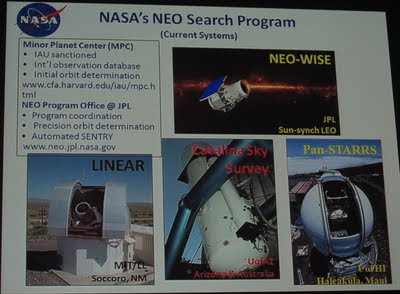
While creating my post yesterday for all the official NASA twitter feeds, I was surprised to note that the Near Earth Objects Program, colloquially known as "Asteroid Watch" or "Spaceguard", is approaching a million followers!
Are folks really that worked up about asteroids hitting Earth? Well, in answer to my question, the man tasked with teaching us about the NEO Program had the Arizona Meteor Crater on his introduction slide, LOL! So there you are. Things can and do hit the Earth from time to time, and will continue to do so.

Want to see one? It so happens that this coming Monday, June 27, 2011... a school-bus-sized asteroid NASA has named "2011 MD" will come within 12,000 kilometers (or 7,500 miles) of Earth. Not the closest or largest that has skittered near our atmosphere, but visible by amateur telescope from many areas – and a fine chance for NASA to examine the properties of the asteroid in infrared, radar and visual observations.
The asteroid will pass so close, that Earth's gravity will quite sharply alter the asteroid's trajectory, whereupon it will move through our zone of man-made orbiting satellites; however, astronomers say there is only a very remote chance of anything colliding.
KNOWN: 500,00 minor planets
7,750 Near Earth Objects (NEO)
1,200 Potentually Hazardous Asteroids (PHA)
You wouldn't think anyone could make killer asteroids so blasted hilarious, would you?! The speaker above, NEO Project Manager Don Yeomans, started by highlighting the architecture of the solar system, as such: we have rocky planets in the inner region, gaseous giants further out, various "belts" of leftover small bodies and a distant comet cloud. Simple enough, right?
Yes, well perhaps in 1900, when we shrugged about it because we simply didn't have the technology to spot much of anything. He zoomed through slides showing discoveries in 1950, 1990, 1999 and finally 2011. And. Wow. It suddenly starts to seem rather amazing that we don't have more craters.

While conventional wisdom of past eras of science suggests the main "asteroid belt" lies roughly between the orbits of Mars and Jupiter, but in more recent days, stargazers are learning that asteroids can make very close approaches to Earth with far greater frequency than previously assumed.
So, if you happen to be short of things to worry about currently, definitely check out the NEO web site for all the amazing tools used to spot near-Earth objects, and you can also keep up with potential disaster movie plots on their Sentry Risk Table.


































































